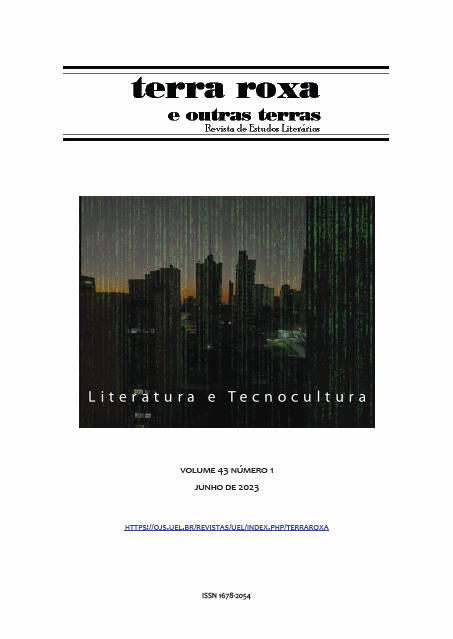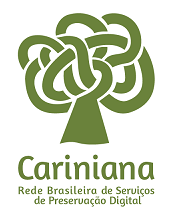We can remember it for you: vision and media in Philip K. Dick
DOI:
https://doi.org/10.5433/1678-2054.2023vol43n1p98Keywords:
Bildwissenschaft, Imaginary Media, Science fiction cinema, Philip K. Dick.Abstract
Science fiction uses speculation on the development of science as a resource to propel us to faraway or future worlds, technologically more advanced than ours. Said speculation does not only consider sophisticated transportation systems that can travel through space and time, but also imaginary visual media such as holograms, videocalls, and even memory alteration gadgets. This essay proposes a reading of the imaginary visual media that appear in three films based on the work of Philip K. Dick, using the media archeology categories. The aim is to place the imaginary visual media in their historical and discursive contexts, elucidate how they relate with the work of the American writer- as they are not necessary present-, and especially, to understand certain problems concerning Bildwissenschaft, such as the human body as a medium of the image.
Downloads
References
BELTING, Hans. Antropología de la imagen. Buenos Aires: Katz, 2007. DOI: https://doi.org/10.2307/j.ctvm7bcgx
BOLTER, Jay David & Richard Grusin. Remediation. Understanding New Media. Cambridge: MIT Press, 1999. DOI: https://doi.org/10.1108/ccij.1999.4.4.208.1
BONITZER, Pascal. Cine y pintura. Buenos Aires: Santiago Arcos, 2007.
CARRÈRE, Emmanuel. Yo estoy vivo y ustedes estáis muertos. Un viaje en la mente de Philip K. Dick. Barcelona: Anagrama, 2018.
CHASTEL, André. El cuadro dentro del cuadro. Madrid: Libros de la resistencia, 2015.
CRUMB, Robert. The Religious Experience of Philip K. Dick. Weirdo, n. 17, 1986.
DICK, Philip K. Dick. Minority Report. The Philip K. Dick Reader. New York: Citadel, 1987. 323-354
DICK, Philip K. Dick. Sueñan los androides con ovejas eléctricas. Buenos Aires: Edhasa, 2003.
DICK, Philip K. Dick. We Can Remember It For You Wholesale. The Philip K. Dick Reader. New York: Citadel, 1987. 305-322.
ENNS, Anthony. Media, Drugs, and Schizophrenia in the Works of Philip K. Dick. Science Fiction Studies, Greencastle, vol. 33, n. 1, “Technoculture and Science Fiction”, pp. 68-88, 2006.
HAYLES, N. Katherine. How We Became Posthuman. Virtual Bodies in Cibernetics, Literature, and Informatics. Chicago: U of Chicago P, 1999. DOI: https://doi.org/10.7208/chicago/9780226321394.001.0001
HUHTAMO, Erkki & Jussi Parikka. Introduction: An Archaeology of Media Archaeology. Erkki Huhtamo & Jussi Parikka, orgs. Media Archeology. Approaches, Applications, and Implications. Berkeley: University of California Press, 2011. 1-24. DOI: https://doi.org/10.1525/9780520948518
KLUITENBERG, Eric. On the Archaeology of Imaginary Media. Erkki Huhtamo & Jussi Parikka, orgs. Media Archeology. Approaches, Applications, and Implications. Berkeley: University of California Press, 2011. 70-94.
LAPOUJADE, David. La alteración de los mundos. Versiones de Philip K. Dick. Buenos Aires: Cactus, 2022.
MACCIAVELLO, Carla. Una vez grandiosa entre las naciones: Conversación entre Leah Modigliani y Carla Macchiavello. Cuadernos de arte, Santiago, n. 22, p. 71-89, 2018.
MANOVICH, L. The Lenguage of New Media. Cambridge: MIT Press, 2001.
MITCHELL, William John Thomas. La ciencia de la imagen. Iconología, cultura visual y estética de los medios. Madrid: Akal, 2019.
STOICHITA, Víctor. El ojo místico. Pintura y visión religiosa en el siglo de oro español. Madrid: Alianza, 1996.
TAGLE, Muriel. Un universo de información: Philip K. Dick desde la mística. Forma: revista d’estudis comparatius: art, literatura, pensament, Barcelona, vol. 9, p. 51-68, 2014.
Filmografía (ordem cronológica)
Blade Runner, dirigido por Ridley Scott, 1982.
Total Recall, dirigido por Paul Verhoeven, 1990
Minority Report, dirigido por Steven Spielberg, 2002.
Downloads
Published
How to Cite
Issue
Section
License
Copyright (c) 2023 Paula Dittborn

This work is licensed under a Creative Commons Attribution 4.0 International License.
Authors who publish in this journal agree to the following terms:
a) The authors retain the copyright and grant the journal the right of first publication, the work being simultaneously licensed under the Creative Commons Attribution-NonCommercial 4.0 International License, allowing the sharing of the work with acknowledgment of the authorship of the work and initial publication in this journal.
b) Authors are authorized to assume additional contracts separately, for non-exclusive distribution of the version of the work published in this journal (eg, publish in an institutional repository or as a book chapter), with acknowledgment of authorship and initial publication in this journal.
c) Authors are allowed and encouraged to publish and distribute their work online (e.g. in institutional repositories or on their personal page) after the editorial process, as this can generate productive changes as well as increase impact and citation of the published work (See The Effect of Open Access).
d) The authors of the approved works authorize the journal to, after publication, transfer their content for reproduction in content indexers, virtual libraries and the like.
e) The authors assume that the texts submitted for publication are of their original creation, taking full responsibility for their content in case of any objection by third parties.



















